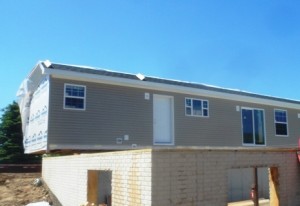Steps on How General Contractors Realize the Modular Homes on a Poured Concrete Basement
How does a general contractor put into reality the modular home on a poured concrete basement?
Pouring a concrete foundation correctly is critical because it holds your entire home steady and secure over time. When building a new home, whether you choose to do some of this work yourself or plan on hiring a professional pouring company, it pays to know how a poured concrete foundation should be poured and where this process can go wrong.
Plan Your Modular Home Basement
Before you dig a foundation, you’ll have a piece of land and a vision of what you’d like your home to look like. Before you start tearing up earth, however, you’ll have to determine how deep a foundation is required. On level ground with good soil conditions, your looking at around three feet. For high-moisture soil or homes built on hillsides, you’ll need more. Consult a professional contractor or engineer to determine exactly how much.
Obtain Permit to Construct a Modular Home on a Poured Concrete Basement
Once a plan is in place, either you or your builder needs to obtain the proper local building permits. In an area with a host of newly built homes, this may not seem like a huge concern, but without a permit you could be told — long after the foundation is poured — that your home needs significant changes or has to be completely gutted. Always obtain the proper paperwork.
Prepare The Site
Next, you need to clear the space for your foundation of any large rocks, debris or roots. Again, while this is a process you can tackle yourself you’re almost always better to go with a pro, especially once it’s time to start digging.
Excavate the Site of the Poured Concrete Foundation
With the work site prepared, it’s time to bring in an excavator. The hole created needs to be bigger than the foundation itself, at least two feet on all sides, to allow space for workers. These workers will create forms for your footings, which are wooden frames used to hold concrete in a particular shape when poured. Anywhere from 16- to 20-inch-wide footings are enough to handle the weight of a typical home. If you live on particularly unstable ground or your home is very large, you may need larger footings and forms.
When the footings have dried and fully cured, they’re removed and concrete walls can be built on top of them. Again, these walls are built using forms, and once they’re dry and cured, other critical work such as waterproofing can begin.
Backfill
The last step on how to build a modular home on a poured concrete basement is the backfilling. Soil, rocks, and gravel that were dug beforehand will be placed back on the side of the foundation. This is done to give support and protection to the poured concrete walls.
In case you still have question about modular homes and insulated precast foundation, you may contact Legendary Homes Inc in Jackson, Michigan. A representative will be happy to assist you. Meanwhile you can check our modular home price sheets by signing up to our blog



